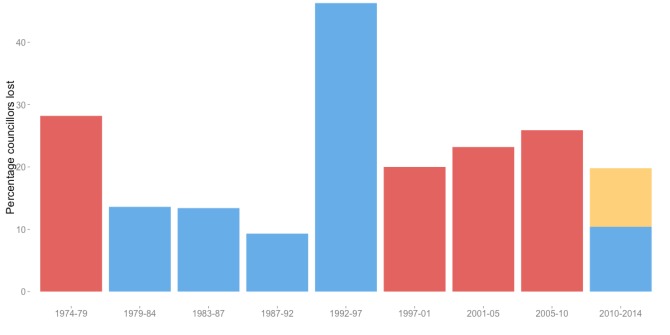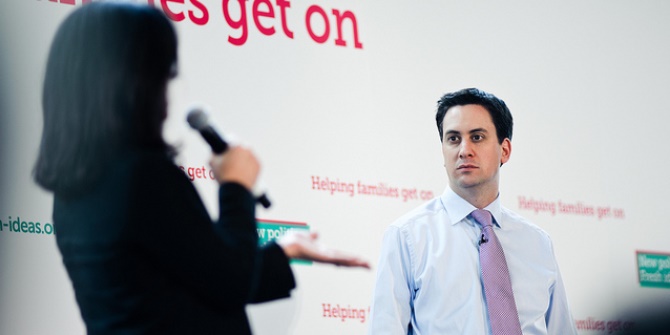
 The further fragmentation of the UK’s party system in 2015 is likely to lead to the most disproportionate outcome of any election in the post-war era. In this post, Jack Blumenau and Simon Hix, along with the team from electionforecast.co.uk, ask what the House of Commons might look like if the election were held under a more proportionate voting system. If members were elected from small multi-member constituencies, the main beneficiaries would be the Liberal Democrats and UKIP, while the main losers would be Labour, the Conservatives and the SNP.
The further fragmentation of the UK’s party system in 2015 is likely to lead to the most disproportionate outcome of any election in the post-war era. In this post, Jack Blumenau and Simon Hix, along with the team from electionforecast.co.uk, ask what the House of Commons might look like if the election were held under a more proportionate voting system. If members were elected from small multi-member constituencies, the main beneficiaries would be the Liberal Democrats and UKIP, while the main losers would be Labour, the Conservatives and the SNP.
After the 2015 election, the debate about reforming the first-past-the-post (FPTP) electoral system for the House of Commons is likely to be back on the agenda. Following the solid majority (68%) against electoral reform in the Alternative Vote referendum in May 2011, it seemed at the time that electoral reform was “off the table” for a generation. Yet, with the prospect of another hung parliament combined with a highly unrepresentative electoral outcome, prominent voices from across the political spectrum are raising the question of whether it is now time for proportional representation (PR). As Daniel Hannan, a well-known Conservative MEP, put it on ConservativeHome.com last week:
“First-past-the-post is groaning and swaying under the strain. Our voting system was designed for two blocs: a government and an opposition. You can see it in the layout of the Commons chamber. But over the past five years we have moved from a two-and-a-quarter party system to a five or six party system. The old argument for first-past-the-post – that it boosts the larger party and so provides stable government – no longer applies.”
Figure 1 shows the “proportionality” of elections in the UK since 1945: where a score of 100 means that each party wins exactly the same proportion of seats in the House of Commons as it’s proportion of votes.[1] In the 1950s and 60s, when the Conservatives and Labour parties won more than 90% of the votes and 90% of the seats, election outcomes were highly proportional. Since the early 1970s, with the rise of the Liberals (who invariably have won a smaller proportion of seats than their votes), UK elections have been far less proportional. And, if we take the latest forecast from the electionforecast.co.uk, the election in 2015 has an 86% probability of producing the least proportional outcome in more than 70 years. This is mainly due to two factors this time: (1) the likely under-representation of UKIP, who could win 14% of the vote and only a couple of seats; and (2) the likely over-representation of the SNP, who could win 4% of UK-wide votes and 50 or more seats.
In the 1980s and 90s the disproportionality of election outcomes was compensated by the fact that FPTP produced single-party majorities, which meant clear winners and stable government. As long as the largest party achieved close to 40% of the vote, it seemed reasonable that it should be given the chance to govern. However, FPTP failed to achieve a majority in 2010 and is it is highly unlikely that either the Conservatives or Labour will win a majority on 7 May. In fact, the probability that either party will win a majority is just 1%.
FPTP works well in a geographically and socially homogeneous country divided into two coherent political blocs, with clear nationwide swings between these two blocs, which then translates into decisive winners. With dramatic geographic and social change over the last 30 years, and the new multi-party system that has produced, Britain is no-longer that country. As a result, we now seem stuck in the “worst of both worlds”: of highly unrepresentative parliaments and no prospect of party winning a majority of seats.
But, what electoral system could give us the “best of both worlds”: a representative parliament, and stable government? Political scientists have been arguing about this for decades, and there are many possible options. One popular option is known as “small-district PR”: where instead of single-member constituencies, these constituencies are combined into small (4 to 8 seat) multi-member constituencies. This form of PR tends to produce an optimal trade-off between a representative parliament and decisive/stable government. Slightly larger constituencies allow smaller parties to win a few more seats, and keeping the number of MPs elected in each constituency to a relatively low number gives a boost to the larger parties and prevents further party system fragmentation, which makes government formation easier and governments more stable.
There are several other virtues of this form of PR:
- it is simple for voters to use (voters could still only have 1 vote);
- it prevents “split-ticket voting”, where in some other forms of PR voters choose 1 party in their constituency and another party on a regional or national list (which leads to further party system fragmentation);
- it allows for a constituency-link to be maintained, although admittedly in larger constituencies; and
- it could easily be combined with some form of preferential voting, such as “open-lists” where voters can choose between candidates within parties.
This electoral system has been used for years in Austria, Denmark, Finland, Ireland, Norway, Spain, Sweden, Switzerland, and many other countries, and has recently been introduced in Chile and Tunisia.
How might such a system work in the UK? First of all, the country would need to be divided up into small multi-member constituencies. One simple way of doing this is to use the current 632 British Parliamentary constituencies (i.e. excluding Northern Ireland) as the building blocks, and to fit them together within historical county boundaries, the local government boundaries within those counties and the London and metropolitan boroughs. Using this method, we drew 114 constituencies, each electing between 3 and 8 MPs. For example, the current constituencies in East Sussex and the Brighton area are combined into two separate constituencies: “Brighton and Lewes” (of Brighton Kemptown, Brighton Pavilion, Hove, and Lewes), and “East Sussex” (of Bexhill and Battle, Eastbourne, Hastings and Rye, and Wealden). The map below depicts how we fit the current parliamentary constituencies (in black) in our new PR constituencies (in red).
Second, we can work out how many seats each party might win in each of these constituencies. The simplest way to do this is to add up all the votes for each party in each of these constituencies and to allocate the seats proportionally to the parties using a standard method (for simplicity we use the d’Hondt divisor method). Based on the latest vote-share forecasts in each constituency, and keeping the current number of Great British MPs constant at 632, here is what the outcome on 7 May might look like if the election operated under this sort of PR system.
The largest changes between the current system and our PR allocation method relate to UKIP, the Liberal Democrats, and the SNP. Both UKIP and the Liberal Democrats would increase the proportion of seats that they are likely to win in the next parliament. The Liberal Democrats’ seat count would increase from the 25 predicted by the electionforecast model of FPTP to 46 seats under this form of PR. UKIP would win 44 seats, up from 1 in the latest FPTP forecast. The SNP would win 32 seats under PR, where electionforecast.co.uk are currently predicting they will win 51 seats. Labour and the Conservatives would both win fewer seats under the PR system described here, with 255 and 250 respectively, compared to 279 and 270 in the current electionforecast predictions.
What are the implications of these differences in terms of coalition formation? Under the first-past-the-post predictions, there is only a 1% chance that any one party will hold a majority of seats after 7 May, and a 59% chance that a two-party combination could collectively hold more than 323 seats (the number of MPs required for an effective majority). The remaining 40% is the probability that no two parties would be able to form a majority coalition. The biggest difference between the two systems is that under the PR system we describe, the probability that no two parties would hold a majority of seats would increase. The probability of the final scenario – of no plausible two-party coalition – increases to 74%. The probability of a two-party coalition decreases to 26%, and the probability of the election producing a majority government vanishes completely.
These differences should not be overstated: under both PR and FPTP models, there is essentially no chance that the 2015 election would result in a majority government – long thought to be one of the key justifications of the FPTP system. While PR would strengthen the position of the smaller parties, and accelerate the declining parliamentary strength of Labour and the Conservatives, it is striking that, in terms of government formation, the first-past-the-post system now produces outcomes that are similar to those that might be obtained under PR.
The big difference, however, is that in a hung parliament under a PR system, the negotiating power of each party would be in proportion to each party’s vote-share, which is not the case under FPTP, where the Lib Dems and UKIP will be under-represented and the SNP will be over-represented in any post-election bargaining. As the plot below shows, the relationship between seat-shares and vote-shares would be much closer under this sort of PR system than under FPTP.
Using the same method of measuring proportionality we described at the beginning of the piece, the expected level of proportionality under this type of PR system would be 86: a level not seen in the UK since the 1970s. It is important to note that this improvement in proportionality comes with little change to the possible governing coalitions of the first-past-the-post system, and still provides a boost to the two largest parties, as Labour and the Conservatives invariably win seats in all constituencies across the country. In other words, such a system could hit an electoral “sweet-spot” between representativeness and accountability that is missed by either first-past-the-post or large district PR systems.
The headline figures also mask another potentially important benefit of the switch to this sort of PR for the larger parties: it would allow them to re-build their party bases in regions in which they have largely disappeared under FPTP. The plot below shows the difference in seat projections for Labour and the Conservatives when moving from FPTP to PR by region. Positive numbers (further to the right on the x-axis) indicate that the party would gain seats in a region, while negative numbers (to the left) indicate that the party would lose seats.
Interestingly, the change to a PR system could allow Labour to increase its stronghold in the North East, and recover some of its losses in Scotland. Crucially, however, Labour would also increase their numbers in the East of England and in the South East – reversing the steady decline the party has seen in these regions in recent elections. Similarly, the Conservatives would dramatically increase their representation in the South West, but also increase their seat numbers in the West Midlands, the North West, London, Wales and Scotland. In sum, while the large parties might experience a decline in overall seat numbers, a shift to PR might enable them to reinvigorate their party support bases in a large number of regions throughout the UK, and hence re-establish themselves as “national” parties again.
Of course, our analysis makes the (completely unreasonable!) assumption that voters’ and parties’ behaviour would remain constant if the electoral system was changed to PR. First, if there was a switch to a PR system, the incentives for voters to vote strategically or “tactically” would be significantly reduced, and would result in a greater share of the vote going to smaller parties than is currently the case. This could lead to fewer votes (and seats) for Labour and the Conservatives and more votes (and seats) for the Liberal Democrats, Greens and UKIP.
Second, the parties themselves would no-doubt change under a PR system. Each party might position itself slightly differently, either more centrist or more radical, depending on how they perceive competition from other parties. Also, new parties might emerge in different parts of the country, although small multi-member constituencies would provide a powerful block against further party system fragmentation. For example, in a 4-member constituency a party would still need at least 20% of the vote to win a seat.
Despite these caveats, we believe that re-running the election under a particular form of PR can still tell us some interesting things about what the consequences of changing the electoral system might be. Any form of PR would lead to significantly more seats for smaller parties, a fairer representation of vote-shares in seat-shares, and perhaps more legitimate post-election coalition bargaining. Also, the PR system we have applied – with small multi-member constituencies – would still lead to higher seat-shares than vote-shares for the two largest parties, would restrict further party system fragmentation, and as a result would make coalition-formation simpler than if a pure form of PR were applied. Small multi-member constituencies based on historical county boundaries (or even smaller units) would also mean that politicians would continue to have local links. And small multi-member constituencies could be combined with some form of preferential voting, such as “open-lists” or a single-transferable-vote system.
In short, electoral reform is likely to be back on the table after 7 May. If so, expect a ferocious debate about what the consequences of various systems might be. We hope our analysis has made a contribution to this debate.
Note: This article was originally published on our sister site, the LSE’s General Election blog, and gives the views of the authors, and not the position of the British Politics and Policy blog, nor of the London School of Economics. Please read our comments policy before posting.
[1] To calculate the proportionality of election outcomes, we use a standard measure that takes the absolute difference between seat and vote shares for each party, sums them, divides by two, and then subtracts the resulting number from 100.
 Jack Blumenau is a PhD candidate in Government at the LSE.
Jack Blumenau is a PhD candidate in Government at the LSE.
 Simon Hix is Professor of European and Comparative Politics and Head of the LSE Department of Government.
Simon Hix is Professor of European and Comparative Politics and Head of the LSE Department of Government.
Chris Hanretty is a Reader in Politics at the University of East Anglia.
 Benjamin Lauderdale is an Associate Professor in Methodology at the London School of Economics.
Benjamin Lauderdale is an Associate Professor in Methodology at the London School of Economics.
 Nick Vivyan is a Lecturer in Quantitative Social Research at the Durham University.
Nick Vivyan is a Lecturer in Quantitative Social Research at the Durham University.














Makes me laugh to read the prediction that the 2015 election has a 1% chance of a Majority Government being elected.
That said, great blog and I agree – MMCs are the future!
The debate about PR will inevitably embrace Scotland. If we want a PR system that works for Scotland and the whole of the UK, the ways in which Scotland benefits from the present electoral system of constituency boundaries needs to be addressed.
Some PR systems, eg the subject of your article, require the use of multi-member constituencies. This would change the nature of the election and campaigning in Scotland because of the far greater geographical size of many of the constituencies.
If the argument is that constituencies should be equalised, while this may seem fair, it may also be seen as a partisan response to the SNP success.
If it is thought to be politically pragmatic for Scotland to have, on average, smaller constituencies than in other parts of the country, it is less acceptable for the Scottish constituencies collectively to have relatively more votes in parliament than the rest of the UK. (parliamentary votes per electorate).
Scotland already has AMS for the Scottish Parliament. How would the General Election look under this or a similar mixed member system?